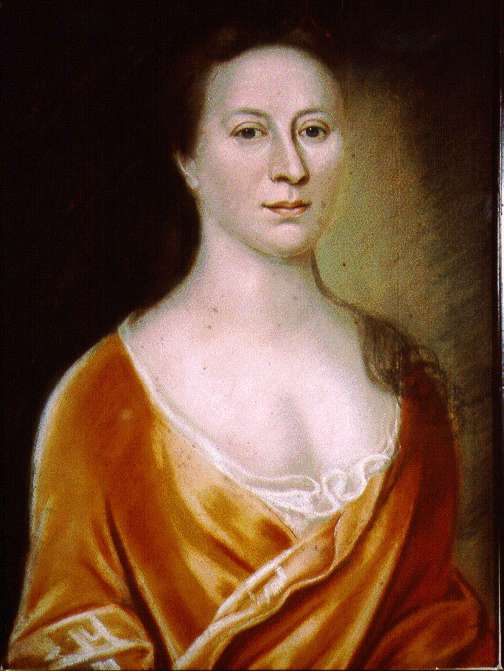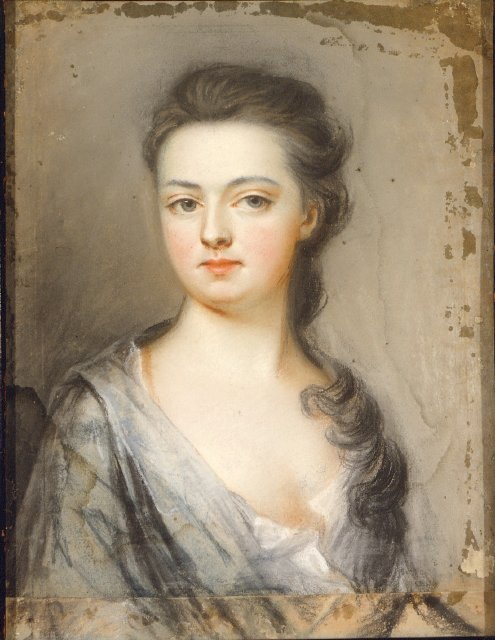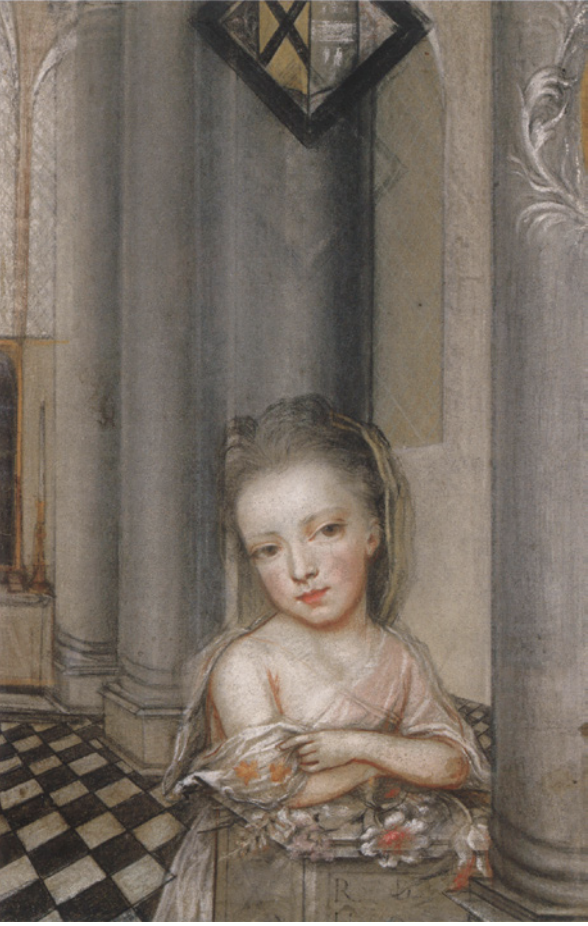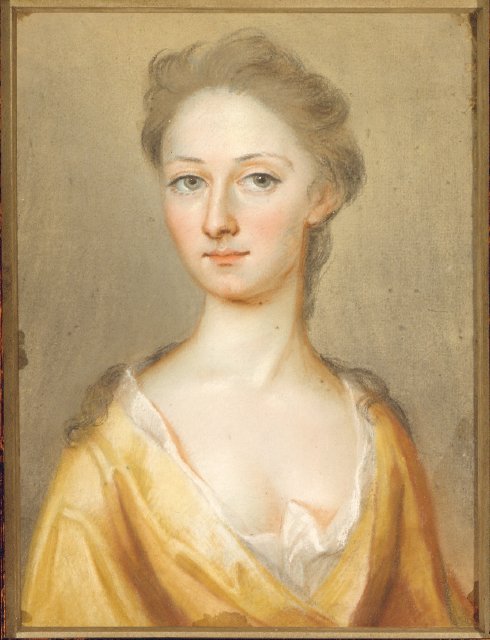Henrietta Johnston
Active in: England, Ireland, Colonial America
Alternate names: Henrietta Dering, Henrietta de Beaulieu
Biography
Henrietta Johnston is considered the earliest artist to work in pastels in colonial America. She was the first professional woman artist to pursue a career in colonial America and has been called the first portraitist of the American South. A practicing artist for nearly thirty years, Johnston’s career started somewhere between 1694 and 1703 and ended with her death in 1729. She began working in Ireland and later produced portraits in England, but most of her work was made in Charleston, South Carolina, where she lived from 1708 until her death in 1729. She was born around 1674 in Rennes, to Francis de Beaulieu and his wife Suzanne. They were a Huguenot family that emigrated to London around 1685 in the wake of Louis XIV’s revocation of the Educt of Nantes, which had protected their right to practice their Protestant faith.
Pastels were a popular medium in London in the 1680s and all of Johnston’s surviving works are pastel portraits on paper. In 1694, Johnston married Robert Dering (1669–1703) and their daughter Helena was born in 1697. Sometime after her birth, the family moved to Ireland where a second daughter, Mary, was born in 1700. Dering died in 1703, leaving Johnston a widow with two children to support. The earliest known portraits by Johnston are dated 1703, suggesting that she began to work as a professional artist to earn an income. Johnston’s daughter Helena died in 1704.
In 1705, Johnston married Gideon Johnston (1668–1716), the Vicar of Castlemore, and she began signing her portraits “Henrietta Johnston.” The family moved to London, where her husband sought to improve their financial situation. Sometime after 1705, Gideon reached out to the Anglican Society for the Propagation of the Gospel in Foreign Parts in search of a new opportunity. In September 1707, they learned that he would be posted as the Bishop of London’s Commissary in Charleston (then called Charles Towne), South Carolina. They arrived in South Carolina in 1708, where they found very challenging circumstances. A rival pastor had installed himself and refused to give up his post and Gideon contracted malaria. Johnston’s earliest American portraits are dated 1708, likely because she needed to generate income for her family soon after their arrival. Among her earliest Charleston works are portraits of two fellow Huguenots, the DuBose sisters, Mary (Marie) and Judith. Both were stepdaughters of Dr. John Thomas, a physician. In 1711, Johnston returned to England to acquire more pastels and paper and to negotiate a higher salary for her husband. She spent two years in England but seems to have produced very few works during this period.
Soon after her return to South Carolina, Gideon left for England and when he returned in 1715, he found that his wife and other members of his parsonage were sheltered in place due to fighting between the Yamasee people and European colonizers. Gideon died in a boating accident in 1716 and Johnston remained in colonial America, living primarily in South Carolina but traveling to New York in 1725. She may have continued to work until her death in 1729 but her last known work is dated 1726. Her accomplishments as a portraitist were widely known and in 1770, Jonathon Armory commissioned John Singleton Copley (1738–1815) to copy a portrait that Johnston had made of his father, Thomas Armory (1682–1728).
Selected Works

Henrietta Johnston, Anna Cuyler (Mrs. Anthony) Van Schaick, ca. 1725. Pastel on paper. New York State Museum.

Henrietta Johnston, Anne Du Bose (Mrs. Job Rothmahler, ca. 1700-1750) , ca. 1720-22. Pastel on paper, 28.5 x 22.5 cm. Gibbes Museum, Charleston, South Carolina.

Henrietta Johnston, Helena Dering (1697–1704), after 1704. Pastel on paper, 46 x 29.7 cm. Private collection.
Circle
Wife of
Robert Dering (1669–1703)
Wife of
Gideon Johnston (1668–1716)
Bibliography
Alexander, Forsyth, ed. Henrietta Johnston: “Who Greatly Helped…by Drawing Pictures.” Portland, OR: Washburn Press, 1991.
Anderson, Dorothy Middleton, and Margaret Middleton Rivers Eastman. St Philip’s Church of Charleston: An Early History Oldest Parish in South Carolina. Chicago: Arcadia Publishing, 2015.
Bolton, Theodore. Early American Portrait Draughtsmen in Crayons. Charleston, SC: Garnier & Company, 1969.
Crookshank, Anne. The Watercolours of Ireland: Works in Pencil, Pastel and Paint c. 1600-1914. London: Barrie & Jenkins, 1994.
Crookshank, Anne. Ireland’s Painters. New Haven, CT: Yale University Press, 2002.
Cooper, William Durrant, ed. Lists of Foreign Protestants and Aliens, Resident in England 1618–1688, London: Camden Society, 1862.
Earle, Alice Morse. Two Centuries of Costume in America, 1620-1820. New York: MacMillan Co., 1910.
Egmont, Earl of. Diary of Viscount Percival afterwards first Earl of Egmont. London: H.M. Stationery Office, 1920.
Figgis, Nicola, ed. Art and Architecture of Ireland. Painting 1600-1900. Dublin: Royal Irish Academy, 2014.
Herdeg, John A. “Re-introducing Helena.” Walpole Society Note Book (1999–2000): 72–75.
Keyes, Homer Eaton. “Coincidence and Henrietta Johnston.” Antiques 16/6 (1929): 420.
Klingberg, Frank J., ed. Carolina Chronicle: The Papers of Commissary Gideon Johnston, 1707-1716. Berkeley, CA: University of Californa Press, 1946.
Middleton, Margaret Simons. Henrietta Johnston of Charles Town, South Carolina: America’s First Pastellist. Columbia, SC: University of South Carolina Press, 1966.
Perry, Lee Davis. More than Petticoats: Remarkable South Carolina Women. Guilford, CT: Globe Pequot Press, 2009.
Roark, Elisabeth Louise. Artists of Colonial America. Santa Barbara, CA: Greenwood, 2003.
Rutledge, Anna Wells. “Who Was Henrietta Johnston?” The Magazine Antiques 3 (1947): 183-85.
Seth, Catriona. “Who Was Henrietta Johnston?” The Magazine Antiques 11 (1995): 704-09.
“Une famille protestante de Rennes: les Beaulieu”, Cahiers du centre de généalogie protestante 27 (1985).
Waldrup, Carole Chandler. Colonial Women. Jefferson, NC: McFarland, 1999.
Willis, Eola. “The First Woman Painter in America.” International Studio 87.7 (1927): 13-20, 84.
Wilson, Rev. Robert. “Art and Artists in Provincial South Carolina.” D.D. Year Book, City of Charleston, S.C (1899): 137-47.
Vaurigaud, Benjamin. Essai sur l’histoire des églises réformées de Bretagne, 1535–1808. Paris: Joel Cherbuliez, 1870.
Entry Notes
For Kim Simpson, whose belief in art has helped transformed the museum and whose presence adds sparkle to the lives of her friends, I dedicate this entry on one of America’s early women artists.—Heidi Gealt

